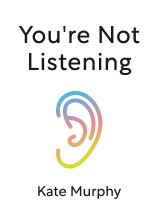

This article is an excerpt from the Shortform book guide to "You're Not Listening" by Kate Murphy. Shortform has the world's best summaries and analyses of books you should be reading.
Like this article? Sign up for a free trial here.
How can you show people that you’re listening? What puts them at ease with you and encourages them to speak frankly?
Listening is critical for healthy relationships. It not only fosters effective communication, but it also shows people that you care. In You’re Not Listening, Kate Murphy recommends finding responses during conversations that encourage the speaker to continue sharing with you.
Keep reading to learn how to get people to open up to you by using specific nonverbal and verbal responses.
How to Get People to Open Up to You
Murphy states that you can become a more effective listener through your responses to the person speaking. Specifically, she shows how to get people to open up to you by using certain responses as you dialogue. We’ll explore nonverbal and verbal responses that can encourage a speaker to share.
1) Nonverbal Responses That Encourage Sharing
To start, Murphy recommends that you adjust your nonverbal communication to show you are listening. Maintaining strong eye contact and a relaxed posture comes across as inviting and encourages sharing.
Also, allow for pauses in the conversation instead of speaking as soon as the other person stops. This gives the other person time to get their whole thought across—which is important because people often don’t say exactly what they mean on their first try. Additionally, encountering a pause often prompts a speaker to elaborate on their point, sharing details they may not have shared otherwise.
(Shortform note: While you’re making eye contact and allowing pauses, make sure that the rest of your body is sending the right signals. Body language experts extend Murphy’s advice, explaining that mirroring a person’s emotions signals active listening. So if someone tells a sad story, it would signal a lack of understanding if your facial expressions reflect delight instead of sadness. During pauses, you can also lean in slightly to clearly hear what someone is saying. Finally, avoid fidgeting with nearby objects or squirming in your chair, as these actions signal boredom and discomfort, even if you’re making strong eye contact.)
2) Verbal Responses That Encourage Sharing
Murphy identifies two types of responses that encourage sharing: open-ended questions and assisting responses.
Open-ended questions allow the speaker to direct the conversation—in contrast to closed-ended questions that steer the conversation in a particular direction. By asking open-ended questions, you can encourage the other person to speak freely about whatever they want.
For example, if someone tells you about getting lost while traveling abroad, you could ask an open-ended question like, “How did you react?” instead of a closed question like, “Did you have a map?” The first question allows the speaker to choose the direction of the conversation, while the second one narrows the conversation to a detail chosen by the listener.
Assisting responses encourage and help the speaker in sharing. We assist someone in sharing when we ask questions that encourage them to elaborate on what’s most important to them. Murphy contrasts this with a redirecting response, which steers the conversation away from what they’re trying to share.
For example, someone tells you they’ve recently gotten into mountain biking. An assisting response would encourage them to talk more about their new hobby, like, “How did you get into mountain biking?” or, “Where do you like to ride?” A redirecting response would steer the conversation away from what they’d like to share, like, “I’ve never really liked outdoor sports. I prefer crossword puzzles.”
(Shortform note: In addition to allowing the speaker to feel heard, open-ended and assisting questions give the speaker a sense of control. When someone can direct the conversation as they see fit, they’re more likely to feel a sense of personal agency and empowerment. In Never Split the Difference, Chris Voss explains that maintaining the speaker’s sense of control is crucial for effective negotiations. If someone feels a lack of control, they may become defensive and thus more reluctant to accept your offer or continue the conversation. We can extrapolate this from negotiations to ordinary conversations. Someone who feels out of control in a conversation may also be reluctant to continue sharing and open up to you. This would undermine the benefits of effective listening, such as building trust and connection.)

———End of Preview———
Like what you just read? Read the rest of the world's best book summary and analysis of Kate Murphy's "You're Not Listening" at Shortform.
Here's what you'll find in our full You're Not Listening summary:
- A look at how listening skills are disappearing throughout society
- How to become a better, more effective listener
- Why it's easier to listen to strangers than to those close to you






